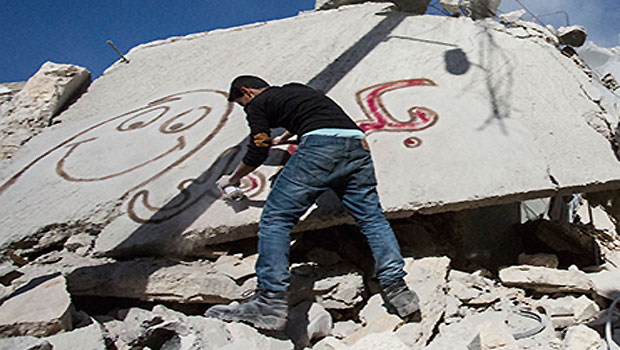
File photo of Syrian Graffiti artist Khalifa at work. (AAA)
Aleppo, Asharq Al-Awsat—Khalifa has a message for the people of ravaged Aleppo: ‘Tomorrow this will be beautiful’.
“It just came into my head one day as I was looking at the damaged buildings,” he says. “I heard that regime soldiers were painting ‘Only Assad, or we burn the country’ on the walls of people’s houses. So I decided to start painting this onto the buildings that they have destroyed in Aleppo, to show that them they have not won.”
Just days after scud missiles have flattened houses in the Al Bab Rud neighborhood of Aleppo, the nineteen-year-old Khalifa can be found spraying his slogan—accompanied by a huge smiley face—on a wall that has somehow remained almost upright in the midst of flattened masonry. A small crowd gathers behind him, while just meters away two men who are dismantling what is left of their home in the hope of salvaging a few possessions take a break to watch him work.
Much of this city is testament to how mush punishment and destruction a building can stand up to and still somehow remain upright and functioning. Shopkeepers open for business at ground level even when the top three floors of their stores are shattered and open to the sky. However the scuds do their damage in one go—for each scud that falls, dozens of houses are flattened entirely.
“This is bullshit for the people,” says Khalifa. “It’s making this city ugly, when it used to be so beautiful. So I hope that when someone sees my message on his house after it has destroyed, it will make him a bit more optimistic.”
Khalifa was an artist before the war, but his canvas then was paper. “My whole family are artists,” he says, “and we had a gallery in Aleppo. When the fighting started here we moved to Arraqa, but when I saw what was happening on the television I felt that I had to come back. That’s when I came up with this idea.”
Spray paint in Aleppo is expensive—around 100 lira for every can—and extremely hard to get hold of. Khalifa works in a sewing factory to earn enough money to buy his materials. “It’s a lot of money for me,” he says, “and it’s very hard to find it in the shops.” The street artists of New York and Berlin use a rainbow of colors in their vibrant pieces, but Khalifa has just three—brown, red and blue. But somehow its sparseness, coupled with its context, makes his work all the more powerful. “I don’t care if my drawings are beautiful or not,” he says, “because it’s the message that’s important.”
But as he finishes his piece in Al Bab Rud some of the watching crowd start to grow angry. Graffiti is not a popular form of art in Aleppo, and Khalifa says that many people think that what he’s doing is nothing more than vandalism.
“Syrians don’t care so much for art,” he says. “They only care for work. But even though they don’t appreciate it now, maybe one day they will see its beauty. I know that the children like it—kids come up to me all the time and tell me that it’s beautiful. That’s enough for me.”
As for whether he intends to continue his graffiti campaign after the war is over, Khalifa says: “I will continue doing this as long as there are newly destroyed buildings for me to paint on,” adding “but I hope that some day soon the destruction will stop and there will be nowhere else for me to paint. When that happens I will become a children’s artist, and I’ll draw my smiley faces in cartoons instead.”
